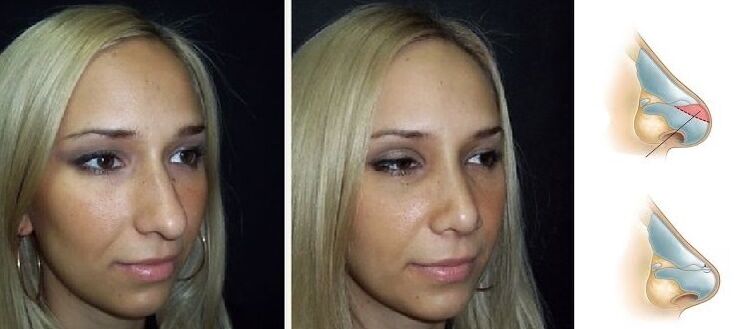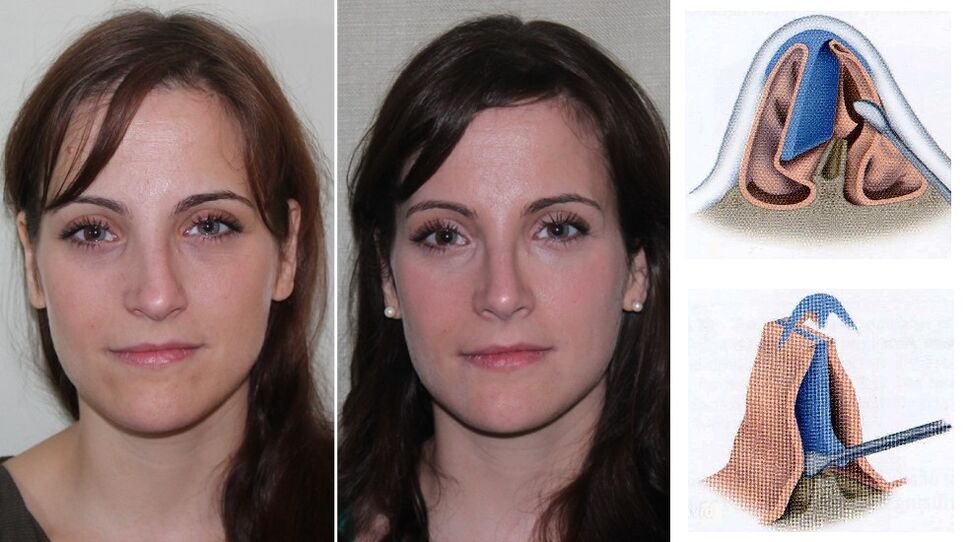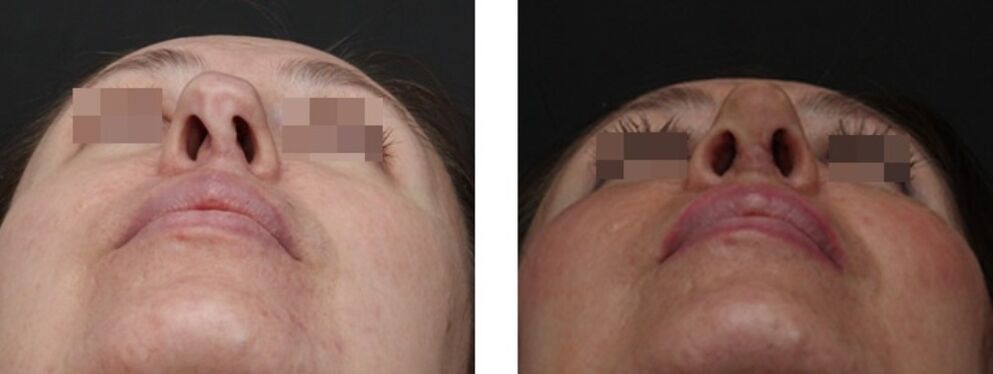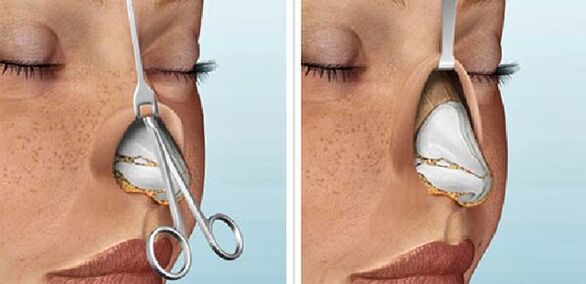
Rhinoplasty (formed from two other Greek words with the meaning of "nose" + "plastic", so it is literally translated as "plastic nose") is a plastic surgery section, which is involved in congenital correction (obtained at embryogenesis level) and nasal deformation obtained throughout life.In short, this is a plastic surgery to correct the external and internal defects of the nose.Differentiate between open, closed and non -curved rhinoplasty.In most cases, aesthetic and functional defects are eliminated by surgery.
Initially, corrections were made only related to injury, serious illness and significant congenital defects.Later, plastic surgery began to perform, most often, according to the aesthetic signs, to change the appearance of the nose.For example, remove the bumps, reduce the ends, lift the nasal bridge, reduce the nostrils and so on. A small story. For the first time, the ancient world surgeon conducted rhinoplasty. He is mentioned in the ancient manuscript "Ayurveda" dated OK.1000 BC This document captures the majority of facts about ancient medicines.The recovery of the face unit is required by the war and the people who are suted in the battle during the execution of the court.Currently, the transfer begins its history.As a ingredient for correction, the cheek or skin on the forehead is taken.Indian technology over time was developed so that in the Middle Ages even European doctors, mastered it, managed to operate in patients.

Hints for rhinoplasty
Rinoplasty is made according to medical and aesthetic guidance.In other words, one person doesn't like what looks like a nose.It can be with bumps or curves, too large or small, wide or narrow, snub -nosed or long, with a large nose or asymmetric.And it happens that a person's nose is twisted from birth or due to a shot (while he is often unable to breathe and surgery is required to restore nasal breathing).There are frequent cases when surgery is needed to correct the appearance defect after the first unsuccessful sensitivity (this is considered the most difficult surgical intervention).This operation is only allowed to people over 18 (if there is no immediate medical indication).This is due to the fact that bone tissue is formed up to eighteen, and the cartilage is up to twenty.That's why the age is best for rhinoplasty from 20 - 35 years.Here are the most common problems with men and women turning to rhinoceros.
Nose with bumps
The essence of the problem: there is a small bump on the back of the nose, as the nose looks bigger, and the face is pouring and dissatisfied.Reason: Congenital defects may appear after the injury, or possibly due to unsuccessful correction.Removal method: In most cases, in plastic surgery, bumps are released by closed or open methods under general anesthesia.If the back of the nose is too wide, it is necessary to do rhinoplasty with osteotomy (spinal rapprochement)

The back of the nose
The core of the problem: one has a very broad nose, which makes the face big and rough.Reason: Defects may appear after the injury, be congenital or be the result of the removal of unsuccessful bumps.Resolution method: Open correction with osteotomy under general anesthesia.The essence of this technique is part of the back of the back, and then the side parts are brought together.
Nosy's nose is bent
The core of the problem: the back of the nose is asymmetric.Because of the curvature, usually one cannot breathe at all.This problem refers to the functional indicator for surgical correction.How defects arise: in most cases, this is a broken result.Although it occurs that the nasal partition is curved due to the intensive growth of the skull while growing.Is it possible to straighten your nose? In most cases, the operation to equate the partition (septoplasty) is undergoing closed methods under local anesthesia.The essence of the operation is shown in the diagram below.If this is not enough, in such cases they use rinoseptoplasty (when the partition correction is combined with the elimination of other nasal defects).In cases where the injury is serious, they use reconstructive plastic (more serious surgical intervention, which is often carried out in several stages), the part of the plastic surgery study is a method of nasal recovery after serious injury and in cases of complete absence.The task of the surgeon in this case is the recovery of the basic integrity of the bone and skin cherries.
The form of a nose saddle
The core of the problem: the nose is too low.Because of what, the shape of the nose resembles the saddle in the profile.Causes: Congenital defects may arise from injuries when some bone or cartilage is damaged.How can you change the situation? The correct form is restored by moving the cartilage of the costume, the cartilage from the auricle (outside the ear) or by instilling a synthetic implant.
A big nose

The essence of the problem. Too large (long or wide) the nose makes the face unbalanced.Often, in such cases, the ends are very thick.Reason: This defect is most congenital. How do they solve the problem? The nature of the surgical intervention depends on the cause (in some cases it is necessary to reduce the end of the end, in the other -the nasal wings are reduced, but it does happen that it is necessary to remove the bumps).Before deciding that it is possible to make plastic surgeons often use 3D computer modeling.This allows you to see even before operation how the face will appear, after the procedure.
Problems of the tip of the nose
The core of the problem: Proper face proportion is violated due to the wrong shape of the tip of the nose.For example, can:
- Narrow
- Broad
- Round (nose with potatoes or bulbous)
- Lowered (knitting)
- Raised (kurting)
- Bifurcated
How do they solve the problem? The course of operation is considered to depend on the type of problem.
- To reduce the wide end, it is sufficient to tie a large cartilage dome, and on the other hand it is also necessary to cut some cartilage tissue.
- Round -based tips are more frequently needed to remove part of the cartilage, followed by the suitability of the dome, as well as reducing the wings during operation.
- The tip of the bifurcated nose should install the transfer from the cartilage of the patient taken in the ear or rib area, or from the synthetic material.
- Tips may look too narrow due to disruptions associated with loss of rigidity of the cartilage.They are reinforced, also using transfer.
- During the lowering of the nose tip, the surgeon removes part of the cartilage and raises it by sewing, fixing it in a new position.
- Another operation of the operation implies the strengthening of the nose columella to ensure good support at the end.
- There is a third method associated with cutting part of the internal muscles, after which the ends are pulled upwards
- Kournostability is also eliminated in several ways that involve the installation of their own or synthetic transplant at the end or nose bridge.

A big or different nose
The core of the problem: an unbalanced nasal size (too small or too large) or significant asymmetry can interfere with the harmony and worsen the face.How to eliminate defects? The course of operation depends on the source of the problem.They can sew the nasal wings, it may be necessary to strengthen the retirement cartilage, and in some cases it is sufficient to adjust the nasal septum.It happens that it has to raise or reduce the long end of the nose
Contraindications to rhinoplasty
To absolute contraindications where rhinoplasty cannot be made under any circumstances:
- Diabetes I, type II
- Coronary heart disease and other diseases of serious cardiovascular disease in which general anesthesia is contraindicated
- Meningitis, tuberculosis, gonorrhea, brucellosis and other serious viral infections
- System diseases: Red Lupus, HIV, Lepra and others.
- Allergic reactions to anesthesia components.
- Chronic diseases: liver cirrhosis, hepatitis, etc.
- Cancer
- Bronchial asthma
- Blood clotting problem
- Mental illness
Rhinoplasty contraindications (rhinoplasty can be done if the disease is recovered) related:
- Age up to 18 years (correction is only acceptable in the most extreme case)
- Increased inflammation (sore throat, frontal, sinusitis, otitis media)
- Ars, sars
- Skin disease
- Age after 50 years (surgery is performed if there is no chronic disease associated with absolute contraindications)
- Pregnancy, breastfeeding, menstruation
How rhinoplasty passes

Rinoplasty is only done under general anesthesia.The duration of the procedure depends on the complexity of the surgical intervention and varies from 30 minutes to 2 hours.During the first consultation, the doctor offers to make 3D modeling to achieve a complete understanding of the patient.This helps show someone what end results can be expected.When he imagined that it was in the end, it was easier for him to make a conscious choice.Prior to surgery, patients need to pass general and biochemical blood tests and general urine tests.It should also take blood tests for HIV and analysis for blood tests for prothrombin.It is necessary to create an electrocardiogram and take a check with a profile doctor, if necessary.The preparation of patients during the pre -operation period includes the following suggestions:
Two weeks before operation:
- Refuses to drink alcohol (especially carbonated)
- Do not take blood thinners
- Do not sunbathe
- Not smoking
A week before the procedure:
- Acquire all the necessary medications
- Reduce the use of cosmetics
- Buy contact lenses to replace a glass (for people with weak vision)
10 hours before operation:
- Do not drink anything (or drink a minimum amount of liquid)
- Do not use perfume and cosmetics
- Provide unnecessary clothing on your head
- Remove the jewelry
Recovery after rhinoplasty
Complete recovery of tissue after rhinoplasty occurs one year after surgery.To speed up the healing process of tissue and prevent the occurrence of unwanted consequences, it is very important to observe a doctor's recommendation on the postoperative behavior.The first day after surgery, the patient was discomfort due to the fact that he should always wear gypsum and hold the tampon in the nose.This means you can only breathe with your nose, your mouth often dry.The temperature can be increased.I want to drink.It's hard to wash and brush your teeth.Remove the gypsum and remove the tourundas from the nose earlier Impossible to.This can cause unwanted deformation, increased swelling and problems with tissue healing.
Impossible to.This can cause unwanted deformation, increased swelling and problems with tissue healing.
The first four five days of edema will be intensified, and then it will begin to subside.To withstand swelling, it is recommended to make cold compression on the first day.After removing gypsum clothes for about two weeks, people will continue to experience discomfort caused by nasal edema.There may be some loss of sensitivity in the field of surgical intervention.The bruises are still visible.Currently, breathing with your nose is easier. During the recovery, the first week, the Rhinoplast surgeon recommends complying with the following restrictions:
- You cannot eat too salty, spicy, acidic and other, easily digested foods.
- You can't tilt your head, take a bath, lift heavy (including taking a child or animal harder than 5 kg.) And do charging.
- You just need to sleep behind you, on a high pillow.
One will be able to work two weeks after surgery, though necessary to prevent heavy physical labor.Therefore, it is best to plan a vacation for this time to provide a complete rest and rest for a speedy recovery.
Within two months after rhinoplasty:
- It is necessary to periodically rinse the nasal cavity
- You cannot be subject to serious physical effort, play sports or go to the pool
- You can't drink alcohol
- You can't smoke
- Reduce or eliminate coffee consumption
- Prohibited to visit a bathroom or sauna
- It is necessary to prevent direct sunlight on the face
- You can't wear glasses.They affect the shape of the nose bridge, so you have to wait until the bones are fully healed.
Possible complications after rhinoplasty
It is considered a normal condition if after surgery there is a bruise around the eyes and swelling.They are directly due to damage during small vessels.After almost two weeks, the main edema and bruises should go down.
Initial complications include the following problems:

- Bleeding
- Hematoma
- Very strong edema
- Fabric necrosis
- Wound
- The discovery of stitches
- Numbness of the nose end
If this problem arises, it is necessary to turn to your surgeon on time and start treatment in time and prevent further development.
Late complications include:
- Maybe the appearance of the corn bone
- The formation of a keloid scar
- The opinion of the nose
- Bifuration the tip of the nose
- The form of a nose saddle
- The back curvature of the nose
- Asymmetry
- The appearance of a bump in the nose
- Partition perforation
- Breathing is difficult
Most of the complications listed above can be eliminated using repeated operations.Some of them arise due to surgeon errors, some due to the inappropriate behavior of the patient during the recovery period, and some events are explained by various characteristics of the human body.




















